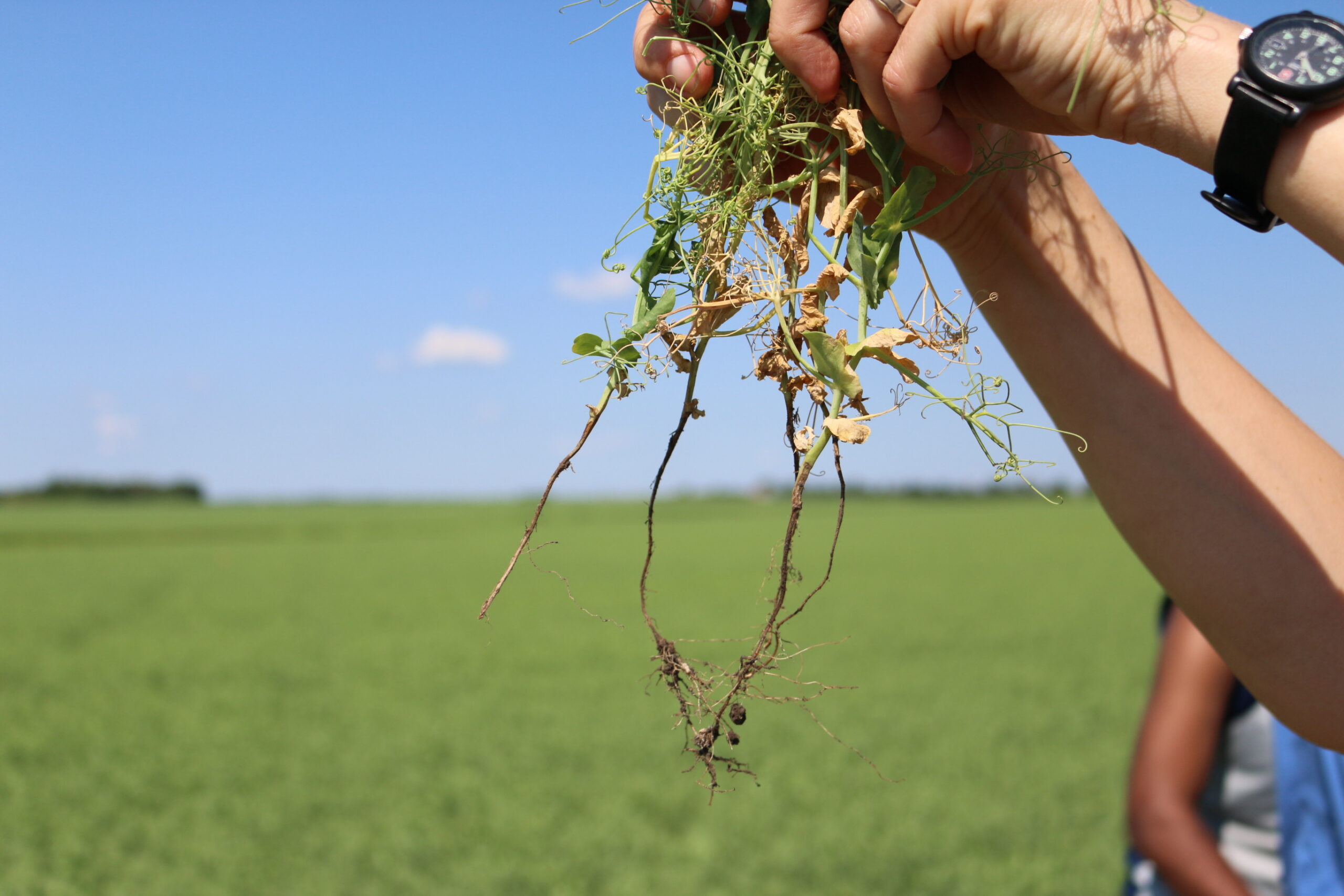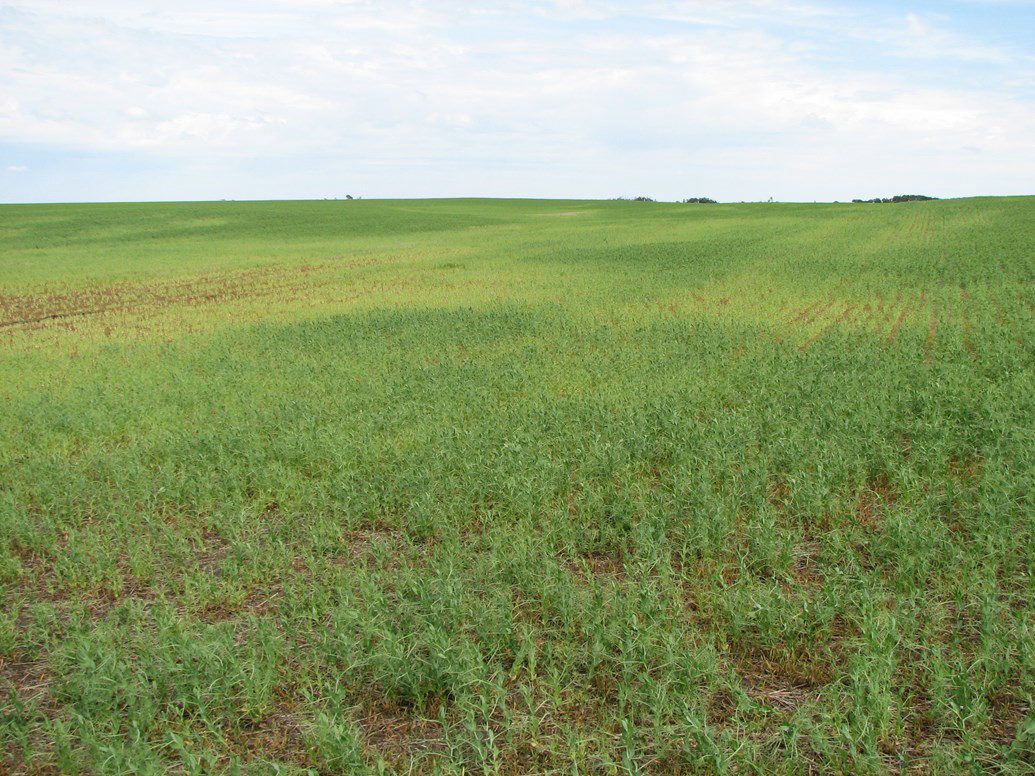Addressing Root Rot Complex in Pulses a Top Priority for SPG
In the last decade, root rot complex has become the top production challenge for Saskatchewan pea and lentil growers.
This soil disease complex, which thrives in wet, warm conditions, has expanded across the province, causing up to 60–84% yield declines in peas and lentils with losses in sales and exports of up to $1.5 billion a year.
Currently, some limited practices or products can effectively control Aphanomyces which is the most devastating pathogen of the root rot complex in pulses. The only option for managing Aphanomyces is long-term rotations (avoiding peas or lentils for 6 to 8 or more years) which has resulted in growers expanding their rotations or moving away altogether from peas and lentils.
At a time when global demand for Saskatchewan pulses is growing, and the environmental benefits of these nitrogen-fixing crops are becoming more and more important, it is critical to remove barriers for pulse growers.
This is why addressing root rot in pulses has become a top priority for Saskatchewan Pulse Growers (SPG).

SPG has been working on this goal for nearly as long as root rots have been an urgent matter in Saskatchewan, investing $10 million into root rot research in the last ten years, leveraged to a value of $25 million with partner funding.
More recently though, SPG has increased momentum around this goal.
In January, SPG announced a $4.4 million investment in root rot research, in partnership with the provincial government Strategic Research Initiative under the Sustainable Canadian Agriculture Partnership. Also announced was a $4.5 million investment in improving new pulse varieties by addressing diseases such as root rot, as part of our partnership with the Saskatchewan Agriculture Development Fund.
SPG has also launched a variety of additional initiatives in key areas. See more details on these initiatives below.
Partnering with Industry
As SPG has learned many times in this industry, working together is always better.
This is why, in 2021, SPG came together with other pulse commissions including Alberta Pulse Growers (APG), Manitoba Pulse and Soybean Growers (MPSG), Ontario Bean Growers (OBG), and Pulse Canada to create a National Pulse Research Strategy.
The purpose of the National Pulse Research Strategy is to: identify impactful and realistic goals for combatting root rot in Canadian pulse production; create a clear and effective strategic plan to achieve those goals; and leverage research investments.
One of the top priorities to come out of the NPRS strategy was controlling root rots in pea and lentil, as these are the two pulse crops most affected and most likely to incur major losses.
The NPRS also set a priority to target and control Aphanomyces and Fusarium pathogens, the most damaging to pulses and prevalent in Western Canada.
In 2022, SPG partnered with APG and MPSG to launch the Root Rot Task Force (RRTF). The purpose of this group is to coordinate provincial efforts to maintain profitable and sustainable pea and lentil production and eliminate the risk of Aphanomyces root rot complex in Western Canada.
Breeding Resistance
One of the top priorities in the fight against root rot is breeding new pea and lentil varieties with resistance to Aphanomyces and other root pathogens.
Of course, breeding projects take time, but the good news is that work in this area has been going on for the last decade, with support from SPG.
Dr. Sabine Banniza, at the University of Saskatchewan Crop Development Centre, has already uncovered genetic sources of resistance to Aphanomyces root rot pathogens for peas and lentils and developed markers for them. These sources of resistance are currently being tested in new crop lines and Dr. Banniza has just received more long-term funding for this work.
Dr. Tom Warkentin, also at the University of Saskatchewan Crop Development Centre, is currently working on developing high-yielding pea varieties with improved resistance to root rot.
Maryse Bourgault, at the University of Saskatchewan, is leading research right now to determine if having large root systems in pulses can improve root rot resistance, while also improving other plant characteristics.
These are just a few examples of ongoing breeding work, funded by SPG and others. SPG will be sharing more outcomes of this research as it becomes available, and a full list of funded research is available on SPG’s website.
Better Understanding the Disease
To develop effective management strategies for any disease, researchers must first understand how the disease manifests, spreads, and evolves.
Scientists in the Canadian agricultural research community are experts at doing this – and SPG has been supporting their efforts to apply this expertise to root rot in pulse crops.
In the last decade, SPG has invested in research to survey the prevalence, severity, and spread of root rot across Western Canadian pulse crops. SPG has also funded efforts to gather disease data across multiple crop years, which tracks how, where, and why soil diseases evolve and spread.
All this information is useful in helping develop effective management and prevention strategies.
Improving On-farm Management Practices
SPG is also focused on determining how to best control the disease through on-farm practices and tools.
There are integrated pest management practices that can help reduce the impact of root rot complex infections. SPG is currently funding research to determine which of these, or other, practices may be most effective, and potentially discover other control methods.
Funded in part by SPG, Alberta researchers Dr. Syama Chatterton and Dr. Michelle Hubbard are exploring the effectiveness of biological products and other integrated practices – such as seed treatments, fertility treatments, and genetics – on controlling root rot. Dr. Chatterton also recently wrapped up research exploring the use of lime and calcium products to suppress Aphanomyces root rot in pulse crops.
Last year, SPG funded the development of an Aphanomyces Risk Evaluation application (AREA) led by Dr. Steve Shirtliffe at the University of Saskatchewan, designed to determine the risk of infections in specific pulse crops across the province. Growers can access the tool for free by visiting the website.
Sharing Information with Stakeholders
As more information about how to best manage and control root rot in pulses is gathered, it is critical to share that information with our most important stakeholders: growers.
This is why a major part of our RRTF strategy is sharing timely and accurate information with growers across a multitude of mediums, designed to reach you most effectively.
- RootRot.ca: A new website was launched in partnership with APG and MPSG, focused solely on sharing research outcomes, risk assessment tools, and agronomic information.
- Pulse of the Prairies Podcast and Webinars: SPG also released a podcast episode, through the RRTF, as well as a series of webinars, featuring the latest information about controlling root rot in pulses in Western Canada.
- Social media: Information will be shared across SPG’s social media outlets and by email to subscribers, so make sure you are following SPG on Facebook, Twitter (X) or YouTube, and receive SPG’s newsletter.
Looking Ahead to 2030
Going forward, SPG will remain committed to reaching our goal of mitigating root rot in peas and lentils and helping growers control and manage the potentially devastating disease.
SPG will also continue to share the outcomes of all efforts to date.
SPG is confident that, by working together with partners and carrying out the strategic plans and initiatives set out by the RRTF, these goals can be met to ensure a thriving, sustainable future for the Canadian pulse industry.



